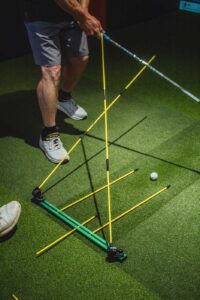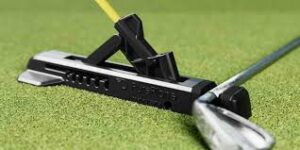WhyGolf Alignment Disc Breakdown: Does It Really Fix Your Slice?
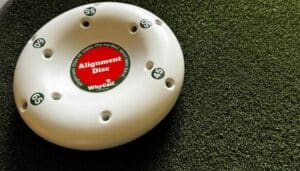
Birdie Score
Price
$129.98
One-Putt Summary
The WhyGolf Alignment Discs excel at fixing over-the-top slices through kinesthetic feedback, but portability concerns and price justification exist
Fairways (Pros)
- ✓ Immediate kinesthetic feedback creates fast awareness
- ✓ Works flawlessly on mats where alternatives fail
- ✓ Superior precision to DIY methods
- ✓ Enables year-round garage/basement practice
Hazards (Cons)
- ✗ $80-120 investment when $5 DIY options exist
- ✗ Portability - big and heavy
- ✗ Fewer angles than competitors
- ✗ Limited functionality compared to competitors in the price range
Best For
Mid-to-high handicappers with persistent swing issues who practice indoors
What Are WhyGolf Alignment Discs (And What They Actually Do)
Here’s the first thing you need to know: the name is misleading. Despite being called “Alignment Discs,” these aren’t designed to help you aim your feet or square your shoulders to the target. Instead, the WhyGolf Alignment Discs are specialized swing path trainers that hold alignment rods at precise angles to create physical boundaries for your club during the swing.
Think of them as guardrails for your swing plane—set up correctly, they force you to swing on the proper path or you’ll smack the rod. It’s simple constraint-based learning: don’t hit the sticks.

The Product Lineup
Original Alignment Discs
$79.99
Heavyweight ceramic construction (5 lbs each) with six angle settings ranging from 45° to vertical (90°). These are the “home gym” version—built like tanks but too bulky to carry regularly in your bag.
Alignment Discs Lite
$49.99
The portable younger sibling, featuring three pre-set angles (50°, 58°, 65°) and ultra-durable foam rods you can swing through without destroying your driver shaft. This is the range-friendly option.
Key Value Proposition
Both versions share the same core value: repeatable, precise angles that work on mats—the critical advantage over shoving alignment sticks into a range bucket or the ground.
Build Quality & Durability: Rock-Solid Construction
What You’re Actually Getting
The original discs measure 13″ x 12″ x 1.5″ and pack serious heft at 5 pounds each. The ceramic construction feels industrial-grade—users report zero structural failures even after thousands of aggressive practice swings. The bright colors ensure visibility during drills, and the angled slots are precisely machined to hold standard alignment rods securely.
The Lite version sacrifices weight for portability, but the foam construction proves surprisingly durable. Multiple users note swinging directly through the foam rods with no damage to clubs or the training aid itself—a massive improvement over the original’s “break your shaft” risk.
The Durability Reality Check
✓ What holds up:
The disc bodies themselves are virtually indestructible. No reported cases of cracking, warping, or slot degradation even with heavy use.
✗ What doesn’t:
If you’re using the original discs with standard fiberglass alignment rods, you will eventually break a shaft if you’re working on an over-the-top swing (because that’s literally the fault you’re trying to fix by hitting the rod).
Build Quality Score
These are built to outlast your golf game
18/20
Effectiveness: Does It Actually Fix Your Swing?
This is where the discs shine—and where expectations need serious calibration.
What They Fix (With Receipts)
Over-the-Top Slices: This is the discs’ specialty
Users consistently report transforming steep, out-to-in swing paths into shallow, in-to-out moves that finally produce draws instead of banana slices. One YouTuber documented changing his path from steep/outside-in to 3.5-4.8° in-to-out measured on launch monitor after “thousands of shots” with the discs.
The drill is elegantly simple: Position the disc ¾ club-length from the ball, insert rod at appropriate angle (typically 50-65° depending on club), then swing over the rod on your backswing and under it on the downswing. Miss the stick = correct path. Hit the stick = you’re still coming over the top.
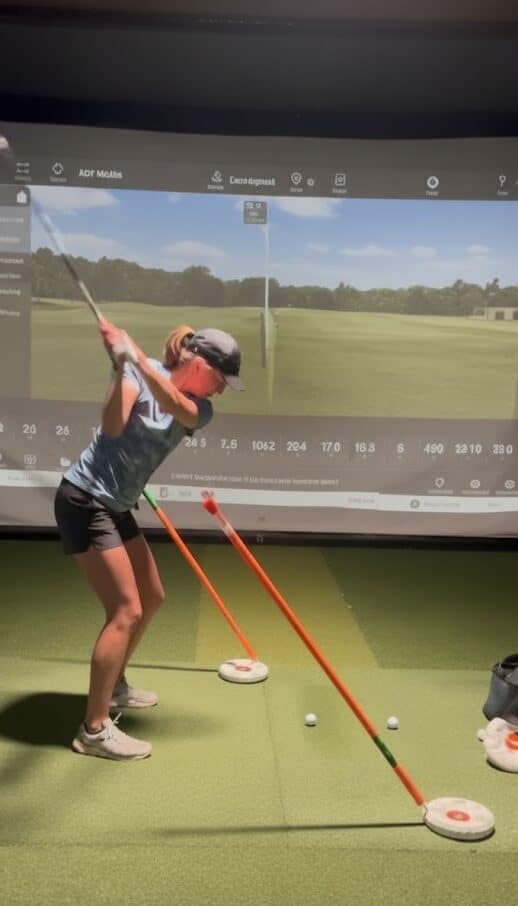
Other Documented Fixes:
- ✓ Excessive in-to-out paths causing blocks and hooks
- ✓ Early extension (hips moving toward ball during downswing)
- ✓ Inside takeaway issues
- ✓ Swaying during backswing
The “Instant Results” Myth
Here’s where marketing meets reality:
Yes, users report “fixing” their swing in “one session” or “a matter of days.” But what they’re actually describing is awareness, not mastery.
Phase 1 (Days 1-7):
The peripheral vision cue from the rod creates instant feedback that makes your swing flaw impossible to ignore. You’ll likely hit some pure shots and experience the “aha!” moment of finally feeling what a proper path should be like. This feels miraculous after years of struggling.
Phase 2 (Weeks 2-8+):
Translating that awareness into permanent motor patterns requires serious volume. Multiple users cite 2,000-4,000 practice swings over weeks to months before changes stick on the course. One user mentioned “completely destroyed” hands from the repetitions required.
What They Don’t Fix
- ✗ Grip issues: The discs provide zero feedback on hand position
- ✗ Weight transfer problems: Unless specifically using vertical rod drills for sway
- ✗ Impact quality: They guide path, not strike location or clubface control
- ✗ Static alignment: Despite the name, these don’t help you aim properly at address
The Limited Angle Problem
Here’s a significant limitation: the WhyGolf discs offer only six fixed angles—45°, 50°, 55°, 60°, 65°, and 90°. While these cover the basics, the 5-degree increments between settings leave noticeable gaps for golfers seeking precise swing plane work.
Compare this to competitors: The Swing Plate features an adjustable hinge mechanism that allows infinite angle variations within its range. The Blue Brick offers more angle options with finer increments. Even the PathPal Alignment Stick Holder provides greater flexibility for dialing in your exact swing plane needs.
For a fixed-angle alignment stick holder at this price point, the limited angle selection is a notable disadvantage. If your ideal swing plane falls between WhyGolf’s preset angles, you’re forced to compromise rather than optimize.
Effectiveness Score
Effective for swing path correction, but limited angle options hold it back
19/30
Ease of Use: Simple Setup, Frustrating Instructions
✓ The Good: Plug-and-Play Hardware
Setup takes 1-2 minutes once you understand the system: place disc about ¾ club-length from your ball position, insert alignment rod at the appropriate angle for your club, make practice swings.
“30 seconds to setup and 2 swings to figure out.” — User Review
✗ The Bad: Trial-and-Error Instruction
WhyGolf provides YouTube videos showing how to set up for draws and fades, but offers almost nothing on achieving a neutral, straight path.
Users report spending days experimenting to find the right disc position and angles for their specific goals.

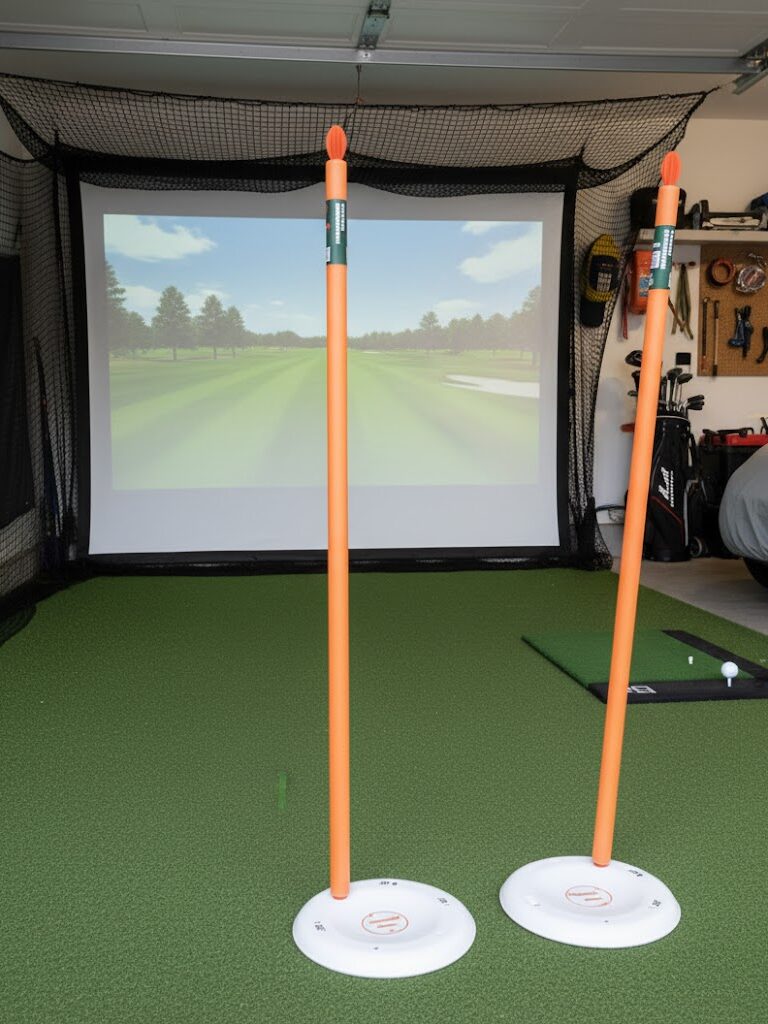
The Portability Trade-Off
| Original Discs | 5 lbs each – stays in garage/simulator. Too heavy for regular range trips. |
| Lite Version | Genuinely portable, fits in carry bag. Practical for driving range sessions. |
| Mat Performance | Both versions work flawlessly – the critical advantage over traditional sticks. |
Ease of Use Score
Simple hardware, but instruction gaps and limited angles create friction
14/20
Value Analysis: Worth It vs. The $3 Hardware Store Alternative?
Original Discs
$89.99
(discs only)
With Padded Rods
$129.98
(bundle)
DIY Alternative
~$5
(bucket + marker)
Let’s be honest:
The function can be replicated cheaply. Stick a fiberglass rod in a range bucket at an angle, and you’ve got the same basic avoidance drill.
Why Users Pay the Premium Anyway
The dedicated practitioners who praise these discs cite three justifications:
- 1. Precise, repeatable angles: No fumbling with buckets or guessing if your setup matches yesterday’s
- 2. Stability on mats: Essential for simulator/indoor practice where DIY solutions don’t work
- 3. Build quality and safety: Especially the Lite foam version that eliminates club damage risk

You Should Buy These If:
- • You practice on mats/simulators 2+ times weekly
- • You’re committed to fixing specific path issues with high-volume practice
- • You value precision and convenience over DIY solutions
- • $80-120 is a reasonable investment in your game
Skip Them If:
- • You only practice on grass ranges where sticks work fine
- • You’re extremely budget-conscious and comfortable with DIY
- • You practice sporadically and won’t put in the reps
- • You’re expecting a magic fix without volume work
⚠️ The Return Policy Gotcha
WhyGolf offers a 60-day money-back guarantee, but you pay return shipping—and these discs weigh 5 lbs each. Users report $15-20 return costs, nearly 20-25% of the product price. This makes the “risk-free trial” significantly less risk-free.
Value Score
Justified for committed practitioners; expensive vs. alternatives
14/25
Versatility: Beyond the Basic Over-the-Top Drill
The Six-Angle Advantage
The original discs’ angle range (45°-90°) enables creative drill setups:
Real-World Applications
- ✓ Full swing path correction (primary use)
- ✓ Chipping and pitching plane work
- ✓ Pre-round warmup to groove feel
- ✓ Post-lesson reinforcement of instructor guidance
- ✓ Indoor/garage practice during off-season
Versatility Score
Genuinely multi-functional within swing path correction niche
5/5
Fairways & Hazards: The Honest Pros and Cons
Fairways (Strengths)
- ✓ Immediate kinesthetic feedback creates fast awareness
- ✓ Works flawlessly on mats where alternatives fail
- ✓ Superior precision to DIY methods
- ✓ Enables year-round garage/basement practice
Hazards (Limitations)
- ✗ $80-120 investment when $5 DIY options exist
- ✗ Portability – big and heavy (original version)
- ✗ Fewer angles than competitors
- ✗ Limited functionality compared to competitors in price range
FAQ: Your WhyGolf Alignment Disc Questions Answered
Will these fix my slice immediately?
Original discs or Lite version—which should I buy?
Can I use my existing alignment rods with these?
Do these actually work on grass driving ranges?
How do I know which angle to use?
Will these help with hooks or just slices?
Can I return them if they don’t work for me?
Are these worth it compared to just using a range bucket?
The Bottom Line: Who Should Buy WhyGolf Alignment Discs?
Best For:
Mid-to-high handicappers (10-25 HCP) fighting persistent swing path issues—specifically slices from over-the-top motion. You practice 2-3x weekly minimum, have access to a simulator, mats, or garage space, and understand fixing swing flaws requires volume work (thousands of swings, not dozens). You value precise, repeatable setup over improvised solutions and view $80-120 as a reasonable investment in a permanent training tool.
Skip These If:
- ✗ You practice exclusively on grass ranges and prefer sticking alignment rods directly in the ground.
- ✗ You’re budget-conscious and comfortable with the $5 range bucket + driveway marker solution.
- ✗ You practice sporadically (less than once weekly) and won’t commit to thousands of reps.
- ✗ You’re seeking quick fixes or expecting instant on-course results without consistent volume work.
Final Scoring
| Category | Score | Max |
|---|---|---|
| Effectiveness | 19 | 30 |
| Build Quality & Durability | 18 | 20 |
| Ease of Use | 14 | 20 |
| Value for Money | 14 | 25 |
| Versatility | 5 | 5 |
| TOTAL | 70 | 100 |
Solid “C+” Training Aid
⛳ The 19th Hole: Final Verdict
The WhyGolf Alignment Discs excel at fixing over-the-top slices through kinesthetic feedback, but portability concerns and price justification exist
Birdie Score: 70/100

